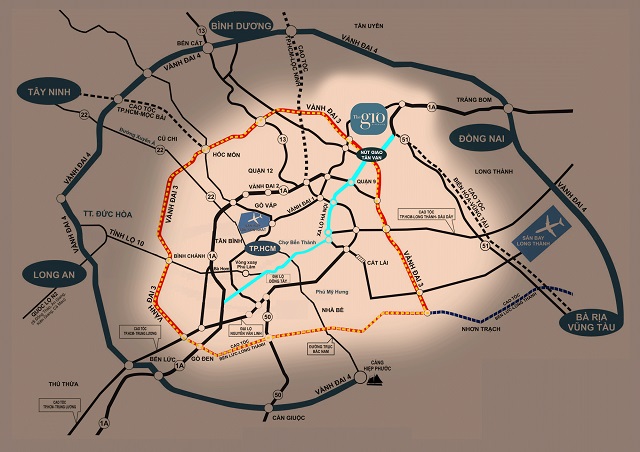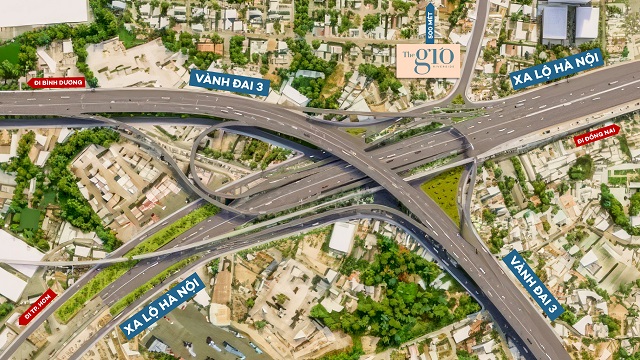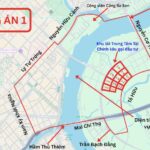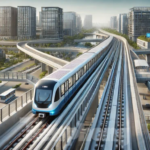Services
The project commenced in May 2024 and is expected to be completed by the end of December 2026, with the Department of Investment and Construction Project Management of Binh Duong province as the investor.
- The Focal Point Connecting 3 Cities
As part of Package XL1, Tan Van Interchange has a length of approximately 2.4 km with a 3-story design and 5 bridge branches. The project directly adjoins 6 major transport routes in the East, including Hanoi Highway, Metro Line 1, Ring Road 3, DT 743A (Section 3), DT 743A (Section 4), and Nguyen Xien Street.
Of these, Hanoi Highway (now Vo Nguyen Giap Street) serves as the most important cross-city axis of Ho Chi Minh City, connecting the East with the city center and expanding westward through Vo Van Kiet Boulevard. In addition, the presence of Metro Line 1 increasingly affirms the role of Hanoi Highway as the backbone of Ho Chi Minh City’s urban transport network.

Tan Van Interchange and Ring Road 3 Map
|
Meanwhile, Ring Road 3 is a strategic inter-provincial transport route, directly connecting Ho Chi Minh City, Bien Hoa (Dong Nai), and Di An (Binh Duong), forming a complete arc to enhance trade and economic development in the East. This route reduces traffic pressure on inner-city routes and opens up a smooth corridor between industrial parks, urban areas, and logistics centers.
The fact that Tan Van Interchange is located at the intersection of the cross-city axis of Hanoi Highway and the inter-provincial transport route of Ring Road 3, along with other vital routes, makes it a rare interchange that combines both urban and regional connectivity.
Upon completion, this interchange will not only significantly reduce traffic congestion on old routes such as National Highway 1A or National Highway 13 but also optimize the connection between the center of Ho Chi Minh City and satellite cities such as Di An and Bien Hoa. At the same time, it will boost economic development and create a breakthrough for the real estate market in the East.
- Advantages of Projects Adjacent to the Interchange
With the advantages of synchronous infrastructure and flexible connectivity, the area around Tan Van Interchange is becoming the focal point of urban development and attracting the attention of investors. Projects adjacent to this interchange will not only directly benefit from the modern transport system but also have the potential for sustainable value enhancement due to population shifts and urban space expansion.
Moreover, compared to projects located on Ring Road 3 but far from major interchanges, projects adjacent to Tan Van Interchange have superior advantages in terms of transport connectivity and commercial potential.

Tan Van Interchange Perspective (Hanoi Highway – Ring Road 3)
|
Firstly, the location at the interchange allows direct access to many important routes, reducing travel time and increasing flexibility. Residents can quickly connect to the center of Ho Chi Minh City via Hanoi Highway and Metro Line 1 and reach Bien Hoa and Di An, Dong Nai in just a few minutes thanks to the expressway and Ring Road 3. In contrast, projects located along Ring Road 3 but far from interchanges depend on branch routes, resulting in longer travel times and reduced convenience.
Secondly, the location at the interchange enables projects to benefit from bustling trade activities, especially in the gateway area connecting Ho Chi Minh City, Binh Duong, and Dong Nai. With a high vehicle density, projects in this area have greater commercial potential, making them conducive to the development of retail, business, leasing, and long-term investment services. In contrast, projects far from interchanges usually have lower commercial exploitation potential due to lower traffic flow than in the central transport hub.
Thirdly, the infrastructure around Tan Van Interchange is being completed, with a series of amenities such as the new Eastern Bus Station, the High-Tech Park, Aeon Mall Bien Hoa, and Thu Duc University Village. This improves the quality of life and enhances real estate value exploitation. In contrast, projects far from interchanges often have to wait a long time for infrastructure development, affecting their potential for value appreciation.
- The Gio Riverside – A Rare Project Adjacent to Tan Van Interchange
Located at the connection point of Hanoi Highway and Ring Road 3, The Gio Riverside by An Gia (Code: AGG) is a project with a strategic location adjacent to Tan Van Interchange, fully exploiting the advantages of the area’s infrastructure.
-2.jpg)
The Gio Riverside Project Perspective
|
The project comprises 3,000 apartments, close to Metro Line 1, and offers convenient access to major commercial centers such as Aeon Mall Bien Hoa, Ho Chi Minh City High-Tech Park, and the new Eastern Bus Station. In addition to its advantageous location, The Gio Riverside also boasts superior amenities and completed legal procedures, positioning itself as a high-end complex by the Dong Saigon River.
Currently, An Gia is expanding its cooperation with over 30 distribution agencies to serve the plan of selling 3,000 The Gio Riverside apartments in the 2025-2026 period.
According to experts, the development of Ring Road 3 and key interchanges like Tan Van will open up significant opportunities for the real estate market in the East of Ho Chi Minh City. As the inner-city land fund becomes increasingly scarce, projects with synchronous infrastructure, convenient connections, and completed legal procedures like The Gio Riverside will become the destination for first-time homebuyers and long-term investors.
Kim Ngan
– 09:00 24/02/2025
“Looking Back and Leaving a Legacy: A Journey Through TA’s Emotional Storytelling”
“TA nhìn lại & để lại” offers a glimpse into the life and legacy of Trần Mộng Hùng, the founder of ACB Bank. This exhibition is not just a showcase of artifacts and memories; it is an emotional journey that brings to life the stories, priceless possessions, and enduring legacies that shaped the bank’s growth and development.
How Much Capital Are Banks Pumping into Ho Chi Minh City’s Real Estate?
As of the end of February 2025, Ho Chi Minh City’s real estate credit balance accounted for approximately 28% of the total credit balance in the area, an increase of 1.15% from the end of 2024. This growth outpaced the overall credit increase, highlighting the vibrant nature of the city’s real estate market and its pivotal role in the local economy.
The New Face of Binh Duong Apartments: Unveiling the Province’s Latest Price Revolution with Rates Climbing to Nearly VND 70 Million per Square Meter
The ripple effect of rising prices in the Eastern area of Ho Chi Minh City is being felt in neighboring regions. While properties in Thu Duc City are priced at 75 – 120 million VND per square meter, just across the border in Binh Duong, prices are currently 30-50% lower. However, this price gap is expected to close in the near future, with Binh Duong potentially catching up.
The Birth of a Global Financial Hub: Proposing a 687-ha International Financial Center in Ho Chi Minh City
The Ho Chi Minh City Department of Finance has proposed two options for the development of a Financial Center, based on thorough surveys and consultations. The department has recommended the second option, encompassing an area of approximately 687 hectares, for the construction of an international financial hub.
An Urgent Proposal for the $4 Billion Metro Line Connecting Can Gio
The Ho Chi Minh City Department of Transportation has proposed to the People’s Committee to request the Prime Minister’s approval for the addition of a new metro line to Can Gio District (Metro Line 12) to the list of projects under the National Assembly’s Resolution 188.





















